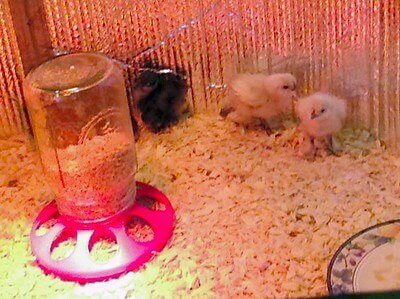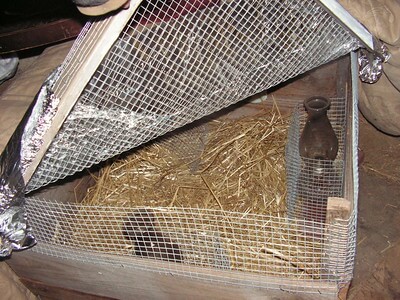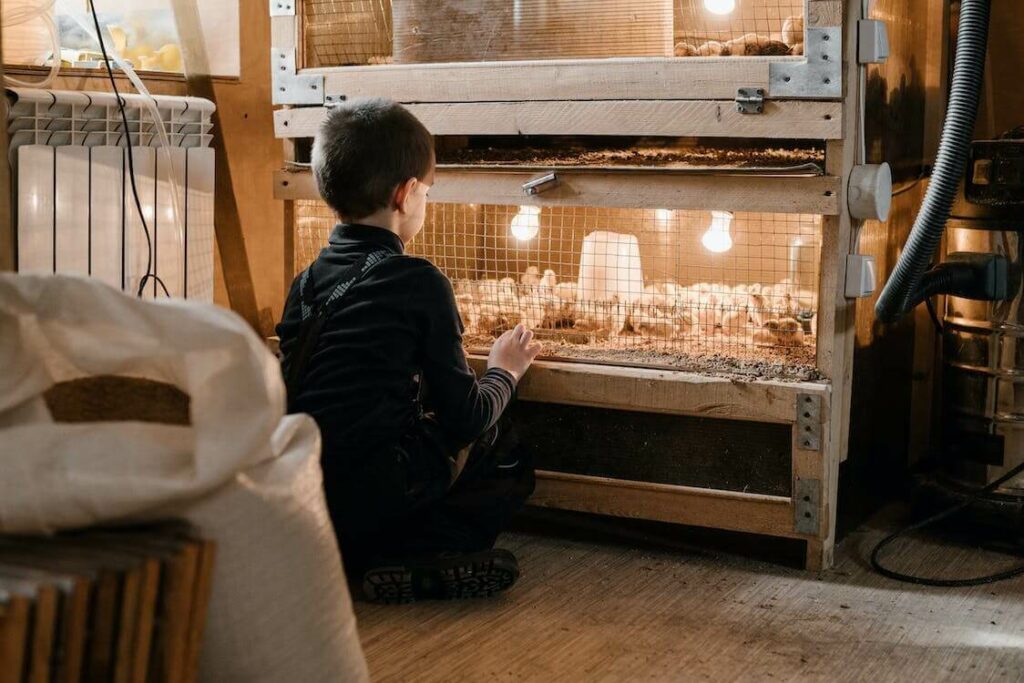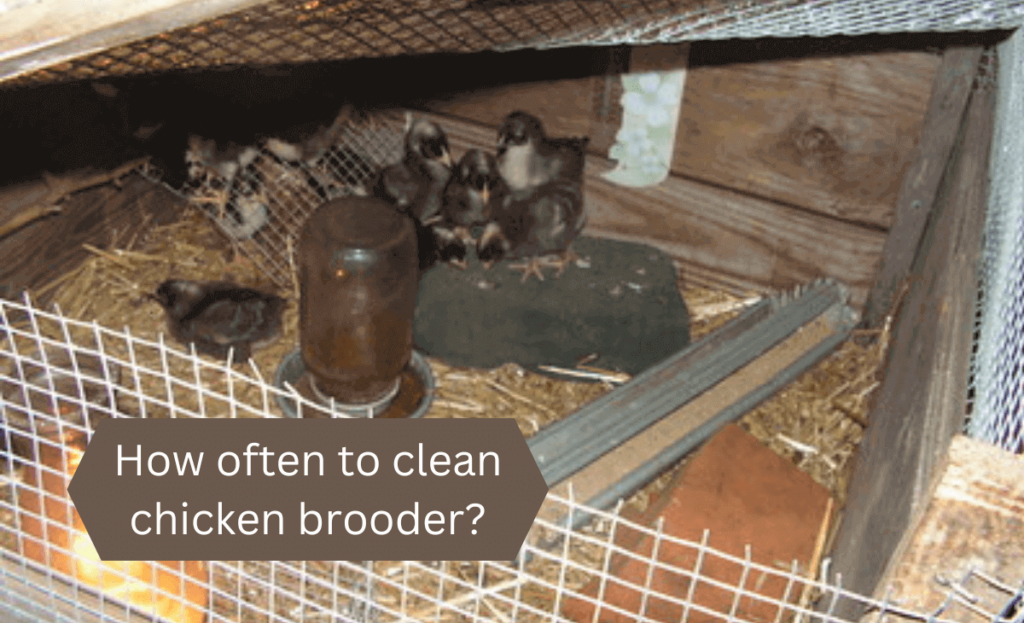The chicken brooder is an enclosed area where baby chicks are reared. Maintaining a clean brooder is essential to the health of your baby chickens. Otherwise, it can lead to disease and even death. So how often should you clean your chicken brooder?
Do you want some tips for raising backyard chickens? This article is definitely for you!
How often to clean the chicken brooder?
Ideally, you should clean your brooder once a week. But if you have a larger number of birds, or if they make a lot of mess, you may need to clean it more often.
You may consider the following questions when determining how often to clean your brooder:
- How many chicks are in the brooder?
- How big is the brooder?
- What type of chicken bedding are you using?
- How often do the birds make a mess?
Tips for cleaning your chick brooder

Cleaning your brooder is a simple process. But first, gather all your supplies before starting so you don’t have to stop in the middle.
1. Remove all the chicken bedding from the chick brooder. This can be done by shoveling it into a wheelbarrow or garbage can.
2. Wash the floor of the brooder with a hose. You can also use a pressure washer to make the job easier.
3. Disinfect the entire box with a solution of 1 part bleach to 9 parts water. This will help to kill any bacteria or viruses that may be present.
4. Allow the box to dry completely before adding new bedding.
5. Add fresh bedding to the box. This can be straw, wood shavings, pine shavings, or other material.
6. Place the baby chickens back in the brooder.
7. Replace the straw fairly frequently because baby chickens love fresh bedding
Chick Brooder Box Basics

Brooders
Brooders can be anything from a simple cardboard box to an elaborate setup with heat lamps and automatic feeders. The important thing is that the brooder is big enough for the chicks to move around in, has plenty of ventilation, and can be kept at a consistent temperature.
Chicks need a warm, draft-free environment when they’re first born. A brooder should be set up before they arrive so that it’s ready for them when they get home. The brooder’s temperature should be between 90 and 95 degrees Fahrenheit for the first week. It can be lowered by 5 degrees each week after that.
A good way to regulate the temperature is to use a thermostat-controlled heat lamp. The heat lamp should be placed over one end of the box so the baby chickens can move away from the heat if they get too warm.
It should also have a water source for the chicks to drink from. A shallow dish or water is best, so the chicks don’t drown. The water should be changed daily to prevent bacteria from growing.
Chicken Bedding
Bedding is necessary for a brooder to absorb the chicks’ waste and keep the environment clean. The bedding should be changed often to prevent the spread of disease. Straw, wood shavings, or paper towels can be used as bedding.
Baby chickens love fresh bedding. Change chicken bedding once a week or more often if it becomes soiled. When changing the bedding, it’s important to disinfect the box to prevent the spread of disease.
Feeders
Chicks need a constant supply of food and water. A Feeder should be placed in the brooder so the chicks can access it easily. And it should be refilled to ensure they have enough to eat.
Waterers
Waterers should also be placed in the brooder so chicks can easily access them. It is recommended to change the water every day to keep it free from chick poop prevent the growth of bacteria.
Ventilation
Chicks need fresh air to breathe, so the brooder should be well-ventilated. Vents can be placed on the sides of the brooder, or a fan can be used to circulate the air.
Heat source

Chicks need a consistent heat source to keep them warm. A heat lamp is a good option, as it can be regulated to maintain the correct temperature.
As the chicks grow, the temperature can be lowered by 5 degrees weekly.
Pasty butt
Pasty butt is a condition that can occur in chicks when their vent gets plugged with feces. This can happen if the bedding is too dry or the chick drinks too much water.
Pasty butt can be prevented by keeping the bedding moist and providing plenty of fresh water for the chicks to drink. If a chick does get pasty butt, it can be treated by gently cleaning the vent with a cotton swab dipped in warm water.
Chick starter feed
Chicks need a special type of feed high in protein and nutrients. This feed is known as chick starter feed with protein content usually between 20-24%. It should be available from when the baby chickens arrive until they are about 6 weeks old.
After that, they can be transitioned to a grower or layer feed.
Dip beaks
Newborn chicks should have their beaks dipped in water to know where to find them. This is known as dipping the beaks and should be done when the chicks first arrive.
The water dish should be placed in the brooder so the chicks can easily find it. Once the chicks have dipped their beaks, they can find the water independently.
Sanitation
It’s important to keep the chick brooder clean to prevent the spread of disease. Change chicken bedding often, and disinfect it regularly.
Water and food dishes should be cleaned daily, and the brooder should be ventilated to keep the air fresh.
Conclusion – How often to clean chicken brooder?
Cleaning your brooder is an important part of keeping your baby chicks healthy. Be sure to clean it regularly and more often if necessary. By following these tips, you can keep your brooder clean and sanitary.
FAQs
How often you should clean the chicken coop?
It is recommended to clean the chicken coop at least once a week and more frequently in hot weather. Clean out old bedding, remove any excess droppings, and disinfect surfaces to ensure a healthy environment for your chickens. Also, make sure to provide fresh food and water daily.
How many chicks can you keep in a brooder?
The number of baby chickens that can be kept in a brooder will depend on the brooder’s size and the chick’s breed. Generally, it is recommended to provide about 1 square foot per chick. So for example, a 10-square-foot brooder could comfortably hold 10 baby chick. It is important not to overcrowd the brooder as this can lead to stress and potential health issues for the chicks.
Can you hatch new chickens from farm fresh eggs?
Yes, it is possible to hatch baby chickens from fresh eggs. However, the eggs must be incubated at the correct temperature and humidity for a certain period of time in order for them to successfully develop into baby chickens. It is also important to note that not all fresh eggs will contain viable embryos. It is best to obtain fertilized eggs from a reputable hatchery if you wish to hatch baby chicks.
Are cedar shavings good for a brooder floor?
Cedar shavings can be used as bedding in a brooder, however, they should not be the only materials used. Cedar shavings have been known to cause respiratory issues in baby chickens and should only be used in limited amounts or avoided altogether. Using non-aromatic wood shavings, straw, or paper bedding as the main material for a brooder’s floor is safer.
What is the ideal bedding material for brooder bedding?
Non-aromatic wood shavings, straw, or paper bedding are all good options for brooder bedding. The material should also be easily disposable and able to soak up moisture from droppings.

